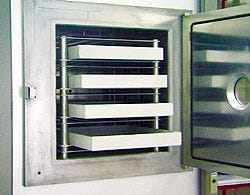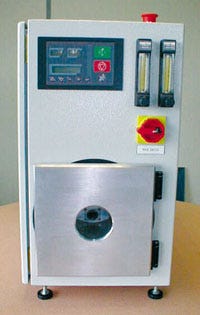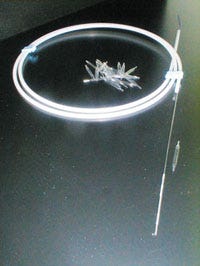Medical Device & Diagnostic Industry MagazineMDDI Article IndexOriginally Published January 2000SPECIAL SECTIONPlasma treatment of material surfaces can impart a range of desired physical or mechanical properties or induce specific biological responses when a device is placed in the body.
January 1, 2000
Medical Device & Diagnostic Industry Magazine
MDDI Article Index
Originally Published January 2000
Plasma treatment of material surfaces can impart a range of desired physical or mechanical properties or induce specific biological responses when a device is placed in the body.
The past decade has witnessed a tremendous surge in interest regarding various techniques for material surface preparation and modification. The critical principle behind these technologies is that they make it possible to change the surface properties of a material without changing the bulk properties. This essentially creates "new" materials with new possibilities, opening novel perspectives to help resolve production or design issues and develop innovative applications. Production difficulties frequently arise when a new material is substituted for an existing one and turns out to have surface characteristics that are incompatible with effective processing. Recent surface modification methods often can address such problems while also inspiring unanticipated design solutions as designers begin to think beyond conventional mechanical or chemical surface alteration.
One such process is low-pressure plasma technology—an environmentally friendly and cost-efficient way to modify material surfaces on a microscopic level without manual operations or the use of chemical products. With this technique, it is possible in a well-controlled and reproducible way to clean, activate, etch, or otherwise modify the surface of plastic, metal, or ceramic materials to improve their bonding capabilities or achieve totally new surface properties. Potential medical applications include modifications of hydrophilic, hydrophobic, low-friction, and barrier surface characteristics. This article will provide an overview of plasma technology, discussing current capabilities as well as possible developments in the future.
GAS-PLASMA SYSTEMS
A plasma is a partially ionized gas containing ions, electrons, atoms, and neutral species. To enable the gas to be ionized in a controlled and qualitative manner, the process is carried out under vacuum conditions. A vacuum vessel is first pumped down via rotary and roots blowers—sometimes in conjunction with high-vacuum pumps—to a low to medium vacuum pressure in the range of 10–2 to 10–3 mbar. The gas is then introduced into the vessel by means of mass flow controllers and valves. Although many gases can be used, commonly selected gases or mixtures of gases for plasma treatment of polymers include oxygen, argon, nitrous oxide, tetrafluoromethane, and air.
A high-frequency generator—which can be in the kHz, MHz, or microwave range—is then used to ionize the gas into a plasma, forming an environment that has been referred to as "the fourth state of matter" (i.e., in the presence of sufficient energy, a solid can be melted to a liquid, a liquid vaporized into a gas, and a gas ionized into a plasma).
 Figure 1. A typical shelf-based gas plasma chamber.
Figure 1. A typical shelf-based gas plasma chamber.
The formed reactive particles react in a direct way with the surface without damaging the bulk properties of the treated part. In fact, the surface modification is limited to the outermost 10 to 1000 Å of the substrate. One distinguishing characteristic of a plasma is a visible glow discharge, with colors ranging from blue-white to dark purple, depending on the type of gas.
Plasma systems generally comprise five main components: the vacuum vessel, a pumping group, a gas-introduction and gas-control system, a high-frequency generator, and a microprocessor-based system controller. Various optional parts can then be added to adapt a base system to handle particular applications or substrates, such as special barrels for small pieces, modified electrode racks, or guiding systems for textiles or fibers. A wide range of equipment is available, from smaller laboratory-scaled systems and custom-designed units to large textile treaters.
PROCESSING MODALITIES
The process of plasma surface modification on polymer, fluoropolymer, and other plastic surfaces can be divided into four distinct mechanisms: ablation, cross-linking, activation, and deposition.
Ablation. The ability of plasma processing to break down weak covalent bonds in a polymer through bombardment with high-energy particles is known as ablation. This affects the outermost molecular layers of the substrate exposed to the plasma, which boils off and is removed by the vacuum. Because the chemistry of any layers of surface contamination is also generally made up of weak C-H bonds, plasma treatment can remove contaminants such as oil films or injection molding additives, thereby leaving behind a uniformly clean and active polymer surface.
Cross-linking. Cross-linking is the setting up of chemical links between the molecular chains of polymers. Plasma processing with inert gases can be used to cross-link polymers and produce a stronger and harder substrate microsurface. Under certain circumstances, cross-linking through plasma treatment can also lend additional wear or chemical resistance to a material. Medical applications for plasma-induced cross-linking include catheters, clinical instruments, and contact lenses.
 Figure 2. A lab-scale, small-volume tabletop plasma system.
Figure 2. A lab-scale, small-volume tabletop plasma system.
Activation. The replacement of surface polymer groups with chemical groups from the plasma is called activation. During activation, the plasma breaks down weak bonds in the polymer and replaces them with highly reactive carbonyl, carboxyl, and hydroxyl groups. Activation can also be performed with amino groups or other functional groups. The resulting change in substrate characteristics will be determined by the type of chemical groups incorporated into the surface.
Deposition. In plasma deposition, a thin polymer coating is formed at the substrate surface through polymerization of the process gas. Depending on the selection of the gas and process parameters, these thin coatings can be deposited with various properties or physical characteristics. Coatings produced in this manner through plasma deposition exhibit different properties than films derived from conventional polymerization, including a high degree of cross-linking and extremely strong adherence to the substrate.
PLASMA APPLICATIONS
Surface modification using gas plasma is a versatile process, with systems on the market capable of treating everything from small components like hubs or balloons up to very large and complex substrates, from fibers, nonwovens, wovens, and paper to plastic foils and metal and ceramic parts.
The various plasma surface treatments and their applications are discussed in the sections that follow.
Materials | Surface Energy | Water Contact Angle |
before | after | before |
Hydrocarbons | ||
Polypropylene | 29 | >73 |
Polyethylene | 31 | >73 |
Polystyrene | 38 | >73 |
ABS | 35 | >73 |
Polyamide/ | <36 | >73 |
Epoxy | <36 | >73 |
Polyester | 41 | >73 |
Rigid PVC | 39 | >73 |
Phenolic | None | >73 |
Fluorocarbons | ||
Polytetrafluoroethylene/ | 37 | >73 |
Fluorinated | 22 | 72 |
Polyvinylidene | 25 | >73 |
Elastomers | ||
Silicone | 24 | >73 |
Natural rubber | 24 | >73 |
Latex | None | >73 |
Polyurethane | None | >73 |
Styrene butadiene rubber | 48 | >73 |
Fluoroelastomers | ||
Fluorocarbon | <36 | >73 |
Engineering thermoplastics | ||
PET | 41 | >73 |
Polycarbonate | 46 | >73 |
Polyamide | 40 | >73 |
Polyaramid | None | >73 |
Polyaryl ether ketone | <36 | >73 |
Polyacetal | <36 | >73 |
Polyphenylene oxide | 47 | >73 |
PBT | 32 | >73 |
Polysulfone | 41 | >73 |
Polyethersulfone | 50 | >73 |
Polyarylsulfone | 41 | >73 |
Polyphenylene sulfide | 38 | >73 |
Table I. Typical material surface-tension and contact-angle values.
ADHESION PROMOTION
Many polymers have a low to medium surface energy—examples include polypropylene, polyethylene, PA, POM, and Teflon. This characteristic makes it difficult to effectively apply adhesives or coatings. Through the use of an oxygen plasma, one can modify the surfaces of these materials such that they obtain the best possible contact with the adhesive or coating. This chemical/physical activation process forms a surface with an optimal number of bonding sites that is entirely free of noncontact zones such as bubbles or pinholes. For example, plasma processing can increase the surface energy of polypropylene from 29 to 72 dynes/cm, which is approximately the value of full water contact. Medical applications include surface preparation for adhesive bonding of catheters and balloon catheters, dialysis filters, and other components, and bonding needles to syringe hubs.
CLEANING
A clean surface on a device or component is deceptively difficult to attain. Conventional cleaning methods can be incapable of removing certain surface films, leaving a thin contamination layer. With plasma treatment, it is possible to achieve outgassing and to completely remove contaminant films. In the same way that weak chemical bonds are removed in the activation process, contamination layers can be eliminated even from complex surfaces. Plasma will remove nonvisible oil films, microscopic rust, or other contaminants that typically form on surfaces as a result of stocking or previous manufacturing or cleaning processes. Even injection molding additives, silicone-based compounds, release agents, and partially absorbed contaminants can be efficiently removed from plastics, metals, and ceramics. Plastic additives not visible to the eye but capable of negatively influencing subsequent manufacturing can be eliminated by plasma without destroying or changing bulk substrate properties.
 Figure 3. Plasma activation of a balloon and catheter prior to bonding.
Figure 3. Plasma activation of a balloon and catheter prior to bonding.
Extremely sensitive instrumentation parts or implants can be cleaned via plasma processing. Ultrafine cleaning of components, electronic assemblies, medical consumables, connectors, and needles are typical applications.
HYDROPHILIC PROPERTIES
A specially developed plasma activation process can be used to make a substrate surface hydrophilic. This permanently hydrophilic character can impart to woven or nonwoven textiles the capability to be used as blood filters or filtering membranes for various applications, including microfiltration components for dialysis filter systems.
 Figure 4. Hydrophobic surface on a plasma-treated nonwoven polypropylene.
Figure 4. Hydrophobic surface on a plasma-treated nonwoven polypropylene.
OLEOPHOBICITY AND HYDROPHOBICITY
Through the use of semicontinuous textile treaters, it is possible to plasma polymerize the surface of nonwovens and other textiles so that they become hydrophobic. This technique is becoming popular with device manufacturers looking to replace conventional methods or improve results through plasma technology. Applications include oleophobic or hydrophobic treatment of paper, textiles, and filter elements.
BIOCOMPATIBILITY
The activation of surfaces to prepare them for cell growth or protein bonding is another important application of plasma modification. Examples of in vitro uses of plasma treatment include preparation of petri dishes and microtiter plates for laboratory experiments or drug-production purposes. The process can also be used to enhance the biocompatibility of implants—for example, by treating the surface of a device to increase the adherence of a hemocompatible coating. Among the applications in this domain are vascular grafts, lenses, and drug-delivery implants. When required, surfaces can also be modified to decrease the bonding of proteins.
LOW-FRICTION COATING
Some silicones and polymers such as polyurethanes have a typically high coefficient of friction against other surfaces. By plasma treating components made of such materials, a polymer coating with a lower coefficient of friction can be applied to create a more lubricious surface.
BARRIER COATINGS
Plasma modification can be used to deposit thin, dense barrier coatings that have the effect of decreasing the permeability of plastic parts to alcohol or other liquids or vapors. For example, plasma treatment of high-density polyethylene can decrease the material's permeability to alcohol by a factor of 10.
STERILIZATION
Gas plasmas are increasingly being employed—especially in Europe—to sterilize the surfaces of medical components or devices. The method uses less-toxic materials than does EtO processing and can be more cost-effective than irradiation.
CONCLUSION
A number of different methods have been developed to modify the surfaces of medical devices and biomaterials to achieve desired physical or mechanical properties or induce a specific response when the device is placed in the body. Among these various techniques, gas plasma treatment offers a numerous advantages:
It is environmentally friendly, consuming little energy, requiring no drying, and presenting no waste-disposal issues.
It is operator friendly, with no personnel exposure to chemicals, toxic gases, or radiation.
All process parameters are fully controllable and repeatable, with quality control provided via print-out and data-logging.
Provides a higher degree of activation and longer shelf life than alternative methods such as corona treatment or flaming.
Causes no substrate damage or bulk property changes.
Permits different plasma processes to be run on the same equipment.
Can be applied to an extensive range of substrates in practically all geometries—small or large, simple or complex.
For many device manufacturers—especially those who continue to use standard chemical or mechanical surface-preparation methods—plasma processing offers a safe, controllable, and reliable alternative.
Johan Palmers is project and process development manager at Europlasma (Oudenaarde, Belgium), a manufacturer of plasma treatment systems, where his responsibilities include R&D and customer processing support. Prior to joining Europlasma, he worked for three years developing hard ceramic coatings at the Scientific and Technical Research Centre (WTCM) of the Belgian metalworking industry. He holds an engineer's degree from the metals and applied materials department of the Catholic University of Leuven.
Return to the MDDI January table of contents | Return to the MDDI home page
Copyright ©2000 Medical Device & Diagnostic Industry
You May Also Like


